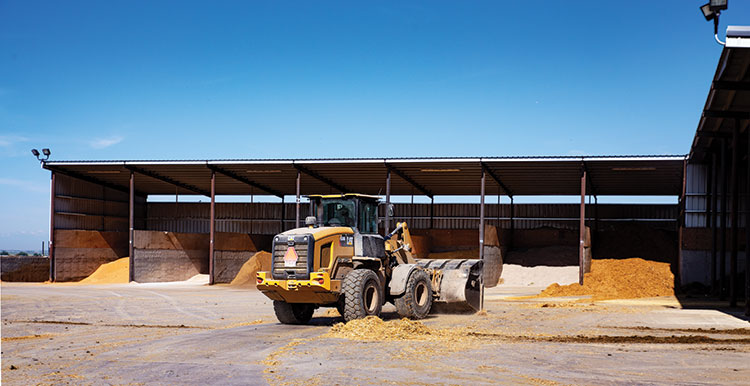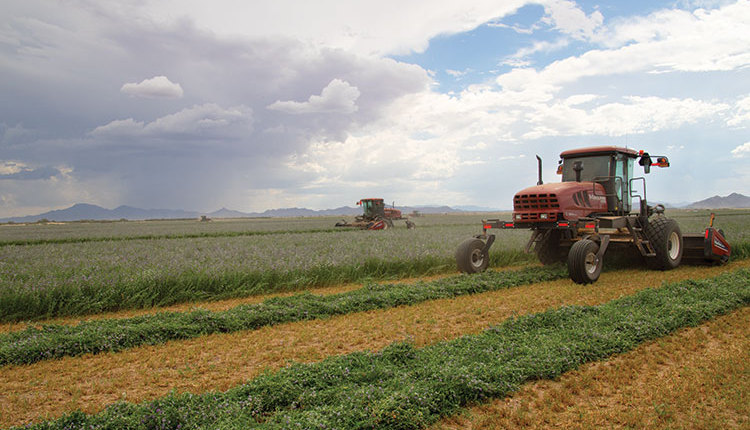
It’s not only the financial statements of many dairies that seem to be on life support this winter and in need of intervention. In addition to low milk prices, dairymen are struggling with a stubborn ration mix of issues that are piling on additional costs.
This past autumn and winter, we have seen “extended dairy ration triage” occurring around the country. Dairy nutritionists have been working overtime, and many dairies are still wrestling with cow performance and related production economics during a time of the year when everyone is usually “dialed in” with their dairy rations until the arrival of new crop forage.
The Upper Midwest has a shortage of alfalfa hay and haylage, particularly high-quality alfalfa. Both corn silage and corn grain lack starch digestibility. Much of the corn silage this fall was harvested too dry as wet weather delayed harvest. Aflatoxins and mycotoxins have also been issues in various Midwest regions, along with premature plant death due to fungal diseases. Cumulatively, forage concerns have hurt dry matter intakes, performance, and financial health.
Dairies in the Northeast and Ontario endured an extremely dry summer, followed by a very wet fall, and have been battling through a horrible mix of forage and feed shortages. What is available often contains unusually high levels of mycotoxins, which requires dilution with cleaner purchased feeds.
Every dairy region seems to be looking for digestible fiber and digestible NDF (neutral detergent fiber) for their diets. This has driven up the cost of any feed with good digestible fiber components to unusually high levels despite low corn and soybean prices. Supplemental starch demand is outstripping the supplies available.
Additionally, planting economics will be a difficult challenge this spring with overall small forage inventories, poor winter weather for alfalfa survivability, excess soybeans still in storage, and economically questionable corn production. With unpaid operating loans and depleted operating capital levels, this presents a very challenging year for dairies and their current and ongoing dairy nutrition.
Searching for fiber
Monitoring and managing your forage and fiber inventories and qualities are especially important this year. Hay and straw supplies are both short and expensive. This has driven the markets for any by-product feed with digestible fiber.
Demand has outstripped normal supplies because these by-products are the only remainders of what’s left from manufacturing a primary product. In some cases, production of the primary product has dropped.
A greater demand for the by-product will not encourage any more production. With demand high and supplies limited, these by-products are being driven by pure market demand, and are not at all reflective of corn and soybean prices. This has been causing “sticker shock” in the countryside.
Soybean hulls, malt sprouts, wheat midds, beet pulp, and corn gluten feed all have more limited availability than normal and have seen greater demand, and their prices reflect it. Soy hulls currently trade in the Midwest in the mid-$160s per ton delivered to the farm.
Malt sprouts supplies are nonexistent with limited domestic beer production. Wheat midds are trading in the mid-$150s on limited supplies as mills typically take more downtime during mid-winter, and the flour orders diminish.
Corn gluten feed supplies have been much more limited as wet corn millers have reduced their corn grinds nearly 50 percent in the past several years due to poor demand for corn syrup and starches. Distillers grain markets have been steady at current levels due to a pullback in ethanol demand balanced out by reduced exports.
Distillers grains present an additional concern for elevated mycotoxin loads as the corn processing method that results in distillers grains concentrates mycotoxins. Then, consider these being added to rations in regions with high mycotoxin and bacterial loads in their silages and forages. Overall ration toxin levels must be considered.
The Red River Valley suffered from an early, hard frost before beet lifting began. The beets healed, but the late beets did not add any further tonnage.
Presently, the sugar plants are about two months ahead of where normal processing on the beet crop usually is. This suggests that beet pulp production will end earlier than normal, contracts will not be fully met, and supplies will run out. Taking possession of your beet pulp early would be recommended.
Exception to fiber shortage
Cottonseed is an exception in the higher fiber by-products. Traditional year-end up charges of $15 to $18 per ton have completely rolled back as dairy producers slowed usage of cottonseed and continue to purchase only hand-to-mouth. The cottonseed markets are hugely unsold compared to normal. Western dairies are only covered through March, which is quite unusual. With a large intended planting for this spring and a large crop currently in storage, cottonseed markets are nervous about demand.
This will keep pressure on the market, particularly with dairies struggling. The only region of strength is the Southeast, trading at $50 to $60 per ton premium to other markets, due to New England’s demand, which is related to the drought and forage toxin issues. Cottonseed quality will be an issue this year due to the wet fall all over the U.S. Watch out for elevated free fatty acid levels going into the spring and summer.
Profitably rationing diets
Financial performance always hinges on solid cow performance. Because of this year’s combination of weather and crop-related issues, added feed costs are a concern compounding the extended low milk prices.
Frequently working with your dairy nutritionist, and closely monitoring feed and forage inventories are absolutely essential this year. With this year’s feeding issues influencing markets, this is not a year to “set it and forget it.” This is a year that will take that extra time, and effort, as even just a couple of pounds per cow per day adjustment may mean the difference between success or failure.










